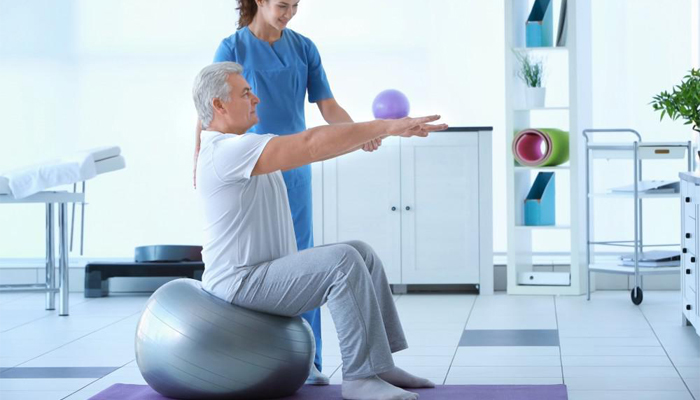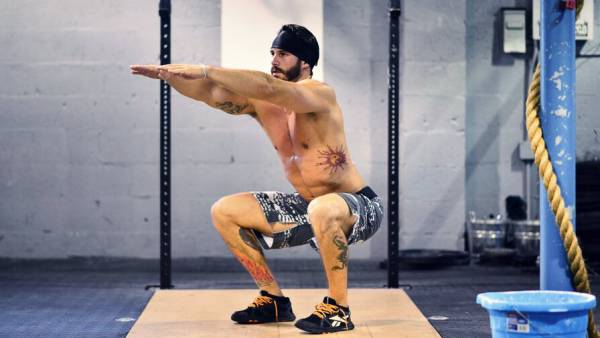Movements like climbing stairs, carrying a trash can to the curb, and bending over to load the washing machine seem natural to you. But As you age, become more sedentary, or change your lifestyle, these seemingly simple tasks can seem as difficult as climbing a mountain or pushing an Olympic sled.
Enter: Functional Fitness, a style of training designed to help you move effortlessly and live pain-free. Here , professional instructors discuss the key elements of the fitness approach, why it's so beneficial, and how you can start incorporating functional fitness into your routine with a six-move workout.
What Is Functional Fitness?
Put simply, functional fitness is a type of training that prepares your body for the movements you perform in everyday life, explains Tina Tang, CPT, an NCSF-certified personal trainer and strength coach.

Source: google.com
In functional training, you can practice movement patterns such as squatting, twisting, pulling, pushing and carrying, which can result in real-life actions such as lifting yourself out of a chair or bend over. and carrying your cat, pushing your child's stroller across the street, and carrying heavy shopping bags in the car.
Utilitarian preparation is, essentially, do practices that will help you. Improve on day to day existence or reinforce day to day exercises," she indicates. "For anybody hoping to lift their grandkid, a useful exercise would be squats with bicep twists.
Functional Fitness This works too, according to Steve Stonehouse, CPT .NASM-certified personal trainer and director of training at Body Fit Training, should be activity-specific training.
Let's say you're going to Hawaii the month next and include some kayaking in your itinerary. You may want to modify your exercise routine to include more pushing and pulling movements so your body can handle these excursions easily, he explains.
Apply what is considered "functional" " exercise. The program is specific to the individual. A person who works as a package delivery person may prioritize more pulling, lifting, and carrying motions than an elementary school teacher whose children you interact with squatting all day.
Functional Fitness vs. Strength Training
If you train functional fitness, strength training will definitely be included in your program. But instead of planning your workout around specific muscle groups, base it on specific movement patterns, says Stonehouse. This means you can hit the gym with squat exercises (think sumo squats, split squats) instead of focusing on your glutes and quads. Functional training can also be done for time (for example, 30 to 60 seconds) instead of repetitions, Stonehouse says.
Finally, developing muscular endurance (the ability of a muscle to generate and maintain force for long periods of time) is as important to daily functioning as muscle strength. (Activities like mowing the lawn and climbing the five flights of stairs to your apartment require muscular endurance.
Although it's not a hard and fast rule: "If you're doing muscle-specific stuff, you probably want to get into the rep counting game,” Stonehouse says. And when you're doing functional things (you're not training for something [specific]), you just want to be a livelier person, live longer and move better), you generally want to do your work right now.

Source: google.com
A functional exercise routine may include the same equipment as basic strength training, including kettlebells, dumbbells and bars. You'll also use tools like your own weight, resistance bands and sandbags, experts say. it's what your body does," says Tang.
With general strength training, you can perform three sets of exercises. Each perform 10 repetitions of squats on a Smith machine. The exercise reduces muscle strength, but the barbell has a predetermined path of motion so the body doesn't have to work harder to provide stability, Stonehouse says.
On the other hand, your functional fitness workout might include three sets of 10 repetitions of walking with a sandbag on your back. The exercise not only puts It tests muscle strength, but it also tests balance, stability, coordination and flexibility, he explains.
Benefits of Functional Fitness
1. It makes everyday activities easier, especially as you get older.
Regardless of your overall fitness goals, functional training is worth pursuing, according to the experts. This gives you the strength to stow carry-on luggage in the overhead bin of an airplane, open a heavy door, and lift heavy boxes off the floor.
But it's especially useful for people over 50, when joints become stiff, balance declines and muscle mass naturally atrophies, says Tang.
Practice squats, lunges, etc. the-Training In contrast, older people may feel more confident and be able to go up and down stairs or sit on the toilet without fainting, he says.
As people "When they get older and break a bone, it may be because they don't have the reaction time, coordination or strength to grab something quickly and stay upright," he explains. Functional fitness is important for everyone, but [especially] for those who are aging to have a better quality of life.
2. Challenge your core
A surprising benefit of functional fitness: it trains your heart without you realizing it. By working with tools that enable dynamic movement, such as sandbags, dumbbells and bands, rather than weight machines with defined motion trajectories, your body can move in any direction.
This means you need to activate your stabilizing muscles, your core, to keep you upright and in good form, says Stonehouse.
See example of the lunge while walking. with a bag of sand on his back. If you don't intentionally brace your core during the big balancing act (you just step forward without thinking), there's a good chance you'll fall while taking a step forward.
3. Trains your body in multiple planes of motion
When programmed correctly, a functional training program challenges your body in all directions of motion: lateral, rotational, back and forth (the latter is overused in most training programs).
Life happens in all three planes of motion, so it is It is very important that we practice on all three planes of movement. of them. Three planes of motion," explains Stonehouse.
Related Article: Maximizing Your Chest Workouts With Dumbbells Without Bench
Consider this: If the subway stops suddenly, you may want to extend one leg out to the side or back to maintain your balance. Practicing lateral lunges and reverse lunges will ensure that you are physically prepared when that moment arrives.
4 Gives a boost to your mind
I'm a firm believer that when you do hard things [like intense training], it's not just your muscles that benefit, says Stonehouse. You regularly prove to yourself that you can overcome and tackle difficult things.
In fact, studies have shown that exercise has been shown to improve mood and independence, esteem and reduce tendencies towards stress and that people who exercise regularly have a better mood, according to a January 2023 "Cureus" study.
Why else would anyone think to make functional fitness training part of your lifestyle? Naturally we get stronger, move better, and live longer, all those wonderful things that everyone knows about. But I think you'll also be a lot happier," says Stonehouse.
An Example of a Functional Fitness Workout
To experience functional fitness, try this six-exercise workout developed by Tang.
Depending on your fitness level, grab a pair of light to medium weights and complete three rounds of the first superset with 60-90 seconds. rest. between shifts. Then repeat the process with main sets 2 and 3. (FYI: A main set is when you do two movements in a row with a few rests in between.

Source: google.com
Yes, although Tang recommends performing 10 repetitions per set of each exercise; You can also work to save time; Consider intervals of 30 to 45 seconds and increase from there.
Is Functional Fitness Right For You?
A functional exercise routine can benefit virtually anyone because its goal is to help you feel and move your body in the best way possible. However, older adults who notice that daily movements or activities are becoming more difficult may prioritize functional exercises, Tang says.
The same goes for people experiencing a more sedentary phase of life due to age, career change, children or an injury, he adds Stonehouse.
Certainly the elderly and everyone else. “Less due to circumstances and additional [functional fitness] needs,” Stonehouse says.
Frequently Asked Questions!
Which Is Better Gym or Functional Training?
On the off chance that you want to develop bulk and fortitude, a conventional rec center exercise might be more reasonable. Be that as it may, assuming that you're seeking work on practical qualification for exercises of everyday living or sports execution, useful preparation may be the better choice.
Can You Build Muscle With Functional Training?
Practical instructional courses can be a viable method for building muscle. These classes frequently integrate practices that impersonate ordinary developments, like squats, lurches, and moving around movements.
Can You Build Muscle With a Functional Trainer?
Coordinating chest area practices into your utilitarian coach exercise routine will reinforce and assemble muscles in your shoulders, chest, arms, and upper back. Here are a few brilliant activities to include: Chest fly.
Is Crossfit Good for Functional Fitness?
CrossFit is made out of three conclusive components: continually differed utilitarian developments, executed at an extreme focus. Any work out regime can at last be portrayed by the developments it decides to focus on. CrossFit decides to focus on utilitarian developments.
Is Crossfit Better Than Pilates?
Pilates are viewed as more straightforward as they are worked for everyone's solace levels and for all body shapes. CrossFit exercises then again are can be extremely escalated. Joining the components of hand to hand fighting preparation and yoga into a mat-based daily practice, Pilates professes to help strength, stance and adaptability.
Should I Do Yoga or Crossfit?
In Crossfit you develop fortitude by tearing the muscle strands and they recuperate into more grounded muscle. Yoga recuperates and rubs your muscles while furnishing offset with a space away from the steady pushing to improve and arrive at new PRs.
